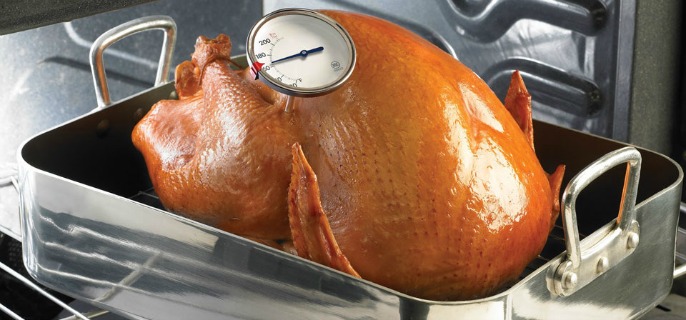
PHOTO COURTEY OF ODA
The holiday season begins next week with Thanksgiving. That means get-togethers with friends, family, and food. Lots of food. The Oregon Department of Agriculture is reminding you to practice good, safe food handling and preparation techniques at all times, but perhaps with a little extra attention to detail starting with the Thanksgiving holiday meal.
“This time of year, there is cause for a little more concern simply because of all the food preparation that takes place in serving a big meal for a lot of people,” says Susan Kendrick, food safety specialist with the Oregon Department of Agriculture.
Proper food handling, preparation, and storage will lead to a safe meal. Slacking off in any of the three areas could spell trouble.
Holiday food safety actually begins as you do your grocery shopping. Cross-contamination of foods can take place right in the grocery cart. Make sure food that might be consumed in a ready-to-eat fashion, such as apples, are kept in a bag. The grocery store provides bags for that reason. They also provide bags for meats to make sure there are no drips that might contaminate other foods.
Once the food purchase is made, head straight for home. It’s always a good idea to make the grocery store the last stop on your list of errands for the day so those foods are still cold and safe when you get them home to your refrigerator. Put groceries away immediately. Don’t leave foods on the counter while you try to get other things done.
The traditional turkey is a centerpiece for the holiday meal. It also deserves close attention when it comes to food safety. Remember that a frozen turkey thaws from outside in. So the surface temperature is going to be warmer a lot longer which raises the potential for growth of food pathogens.
“Don’t just let the turkey sit on the counter for a couple of days to thaw,” says Kendrick. “Put it in the refrigerator. You are going to have to plan ahead. It takes 24 hours for every five pounds of turkey to thaw. So if you have a big turkey, you may need to put it in the refrigerator four or five days ahead of the day you will actually cook it.”
Contrary to what many people think, a turkey should not be washed or rinsed off as you begin to prepare it. That only smears or transfers the bacteria onto your hands or into your sink where, if not immediately sanitized, it could easily get onto other foods or utensils. Immediately throw away any packaging from the turkey and wipe up any drips with a disposable item, like a paper towel.
It’s the cooking of the turkey that will kill the bacteria.
ODA recommends the use of a meat thermometer to make sure you get a good endpoint temperature. That temperature should reach 165 degrees Fahrenheit. It’s also recommended to not put stuffing in the bird. It’s much safer to prepare the stuffing in a baking dish and bake it separately simply because it’s not easy to know what the internal temperature of the turkey is going to be.
It is also unwise to partially cook the turkey the night before, cool it in the refrigerator, and then finish the cooking the next day. Frequent heating and cooling does a good job of promoting bacterial growth.
Chances are turkey is not the only food item being prepared in the kitchen right before the dinner. Other foods– many ready-to-eat items– are being prepared right alongside the big bird. That sets up the potential of cross-contamination.
“Make sure you have separate cutting boards, separate knives and other utensils when you are handling raw versus ready-to-eat foods,” says Kendrick.
Of course, handwashing is an absolute requirement prior, during, and after food handling.
Finally, the dinner is cooked. The guests are served. Everything is delicious and very filling. Dinner is over and it is very tempting to just get up from the table and retire to the living room for conversation. Don’t forget about the leftovers. Put them away in the refrigerator within two hours.








